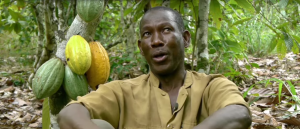Family profile
Put the picture of Halima and her parents on the board (or project them). Put students into pairs and ask them to do a little brainstorming and try to come up with a profile of these three people. They can think of the relationship between the people, their age, the place they come from, their occupation, their dreams, anything. Conduct open-class feedback and put some ideas on the board.
Prediction check
Play the video and check whether the ideas were correct. While doing this, put together the story of the family with the whole group.
Listening for details
Play the video for the second time and ask students to pay closer attention and jot down the context of the following words and figures: sacks / 40% / widespread / fees / awareness raising / tomorrow
1-minute challenge
Ask the group to come up with 20 questions they would ask from Halima or her parents in 1 minute. If students get stuck, help out.
World Day Against Child Labour
Get students’ attention and tell them that you are going to read out 7 words and figures that they have to memorise. They all come from a text they are going to read and complete with these words. Then give students the gapped text and ask them recall the missing items. You might want to ask them NOT to write in the solutions but make sure they know them. After that, nominate somebody to read out the text; if the student gets stuck, have the other members help him/her.
According to statistical data compiled by the International Labour Organization (ILO) in 2008, an estimated ____ million children aged 5 to 14 partake in child labour globally. Out of the estimated 172 million, about ____ million children regularly engage in __________ work that can potentially ___________ their personal safety, mental & physical health, and development. A consequence of the child labour issue is that it doesn’t just limit itself to the service, automobile or _____________ industries. Regrettably, child labour extends itself to practices such as selling or trafficking children, the forced recruitment of child soldiers, using or offering children for _______________, production of pornography, or early ____________. Furthermore, children who enter into bonded or indentured labour contracts often deal with corporal punishments and threats of violence from their employers if they choose to leave the job.
To focus global attention on the urgent need to eradicate this practice, the International Labour Organization has designated June 12 as World Day Against Child Labour.
Sources: http://issues.tigweb.org/childlabour and http://days.tigweb.org/world-day-against-child-labour-65
Key: 172 / 126 / hazardous / endanger / agricultural / prostitution / marriage
Petition writing
Put students into groups of 3. Hand out a paper with the word “Petition” on top and ask them to write a petition to take a stand against the support of child labour. When they have finished, ask them to put their compositions on the walls of the classroom, go around, and read them to see what the others have come up with. (Depending on the proficiency level of your group, you might need to pre-teach some language related to petition writing.)
Note: the idea of petition writing came from http://issues.tigweb.org/childlabour





Child labor is a specific focus in this article of mine on honing social empathy published originally in HLT: 2011 which also links various videos:
https://www.academia.edu/27458288/Honing_Critical_Social_Imagination_Through_a_Curriculum_of_Social_Empathy